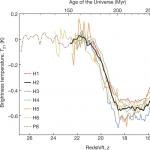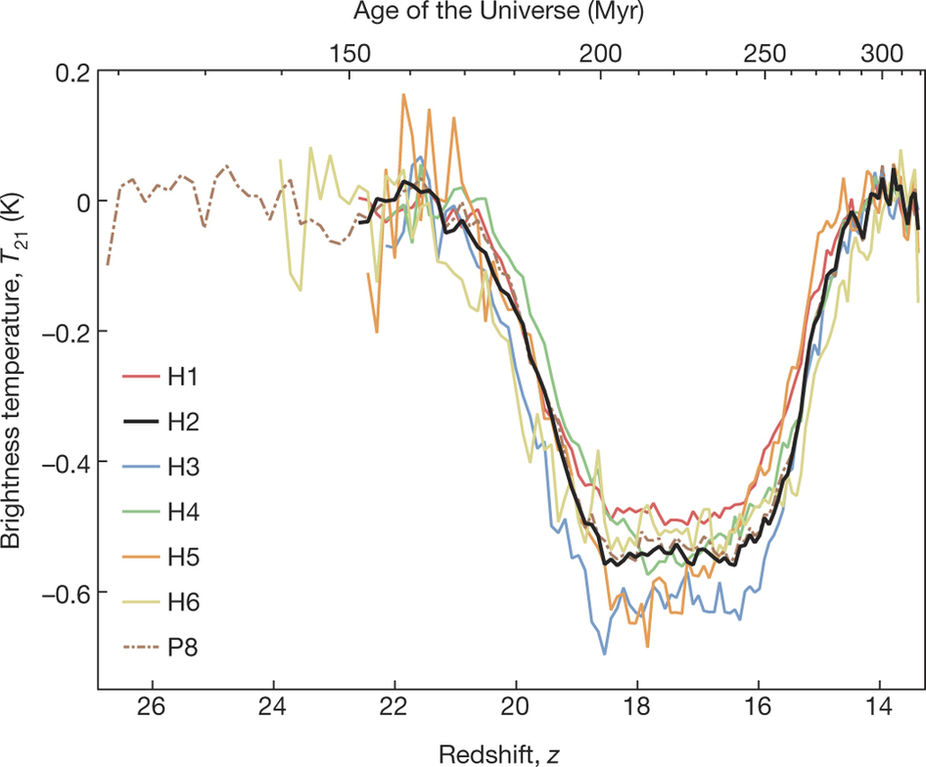Paper of the month: An Unexpected Absorption Profile in the 21cm Spectrum

March 5, 2018 by tiinatimonen
Of particular interest to cosmologists is the hyperfine transition of hydrogen that connects the ground state and a low-lying excited state that is the result of an electron spin flip. This line is of interest to the community for predominantly two reasons: (i) neutral hydrogen is extremely abundant in the Universe, in particular during cosmological epochs for which our current knowledge is quite limited, and (ii) the absorption and emission profile of the 21cm line of neutral hydrogen has been studied for many years and is measured to an extraordinarily high precision in the laboratory. Furthermore, a 21cm line emitted billions of years ago becomes redshifted as a result of the expansion of the Universe, implying that the observed frequency today carries with it information about when this transition occurred. Since hydrogen traces baryon over-densities, and thus matter over-densities, mapping the 21cm line across many frequencies allows cosmologists to accurately determine both the matter distribution and the characteristics of neutral hydrogen across large time scales.
In the context of cosmology, the background light source against which the emission or absorption features of the 21cm spectrum are compared is comprised of CMB photons. It is important to note that in the absence of baryonic interactions, the rate of absorption and emission of CMB photons would be equivalent, implying no observable spectral features (i.e. it would be impossible to distinguish this state of equilibrium from one in which the background photons never passed though neutral hydrogen). Baryonic interactions, however, spoil this equilibrium for redshifts between approximately 6 and a few hundred; specifically, these baryonic effects primarily arise from: (i) excitations induced from atomic collisions, (ii) indirect excitations/de-excitations that result from the presence of Lyman-α photons, and (iii) heating and ionization of neutral hydrogen (see e.g. [2] for a comprehensive review).

Figure 1: Absorption feature measured by the EDGES collaboration as a function of redshift z for various hardware configurations [1]. The thick black line denotes the model fit for the hardware and analysis configuration yielding the highest signal-to-noise ratio.
The 21cm observation made by the EDGES collaboration probes redshifts that are conventionally thought to occur around the epoch of star formation. By this time, gas has collapsed into higher density regions but has not yet produced sufficient energy to heat the intergalactic medium. Instead, an abundance of Lyman-α photons have been produced, which subsequently induce an increase in the absorption rate. The absorption of the 21cm signal is expected to be at its strongest during this epoch, with the overall intensity of the absorption line depending on the baryonic temperature. Indeed this large absorption feature is exactly what EDGES has observed (see Fig. 1, taken from [1]), however there is a rather peculiar aspect of this observation which calls into question the legitimacy of the conventional cosmological model, ΛCDM. Namely, the overall magnitude of this absorption feature is far larger than should be possible given the current knowledge of the Universe. Should this signal be robust against underlying backgrounds and systematics, the most obvious interpretation is that the baryon temperature during this epoch must be significantly colder than predicted in any conventional cosmological model.
If confirmed, this result will have wide-reaching implications for those studying cosmology and dark matter. Many of the most popular dark matter models naturally predict that additional energy should be injected into the intergalactic medium during this epoch (e.g. via annihilating or decaying particles, or via accretion in the case of primordial black holes), which conventionally serve to enhance the overall baryonic temperature and the fraction of ionized hydrogen, subsequently increasing tension with this observation. This is, however, not necessarily always the case. In fact, two groups have already proposed various dark matter related solutions [3, 4]. Successful explanations of the EDGES measurement will likely need to appeal to a mechanism which removes energy from the baryonic sector, but only at a significant rate for redshifts after recombination. The EDGES observation will soon be tested by upcoming experiments such as the Large-Aperture Experiment to Detect the Dark Ages (LEDA), the Sonda Cosmológica de las Islas para la Detección de Hidrógeno Neutro (Sci-Hi), the Probing Radio Intensity at high z from Marion (PRIZM), the Shaped Antenna measurement of the background Radio Spectrum 2 (SARAS2), the Hydrogen Epoch of Reionization Array (HERA) and the Square Kilometer Array (SKA).
Text by Samuel Witte (UVEG)
References
[1] R. A. M. T. J. M. Judd D. Bowman, Alan E. E. Rogers and N. Mahesh, An absorption profile centered at 78 megahertz in the sky-averaged spectrum, Nature Letters 555 (2018) 67.
[2] J. R. Pritchard and A. Loeb, 21-cm cosmology, Rept. Prog. Phys. 75 (2012) 086901, [1109.6012].
[3] J. B. Muoz and A. Loeb, Insights on Dark Matter from Hydrogen during Cosmic Dawn, 1802.10094.
[4] A. Fialkov, R. Barkana and A. Cohen, Constraining Baryon–Dark Matter Scattering with the Cosmic Dawn 21-cm Signal, 1802.10577.


